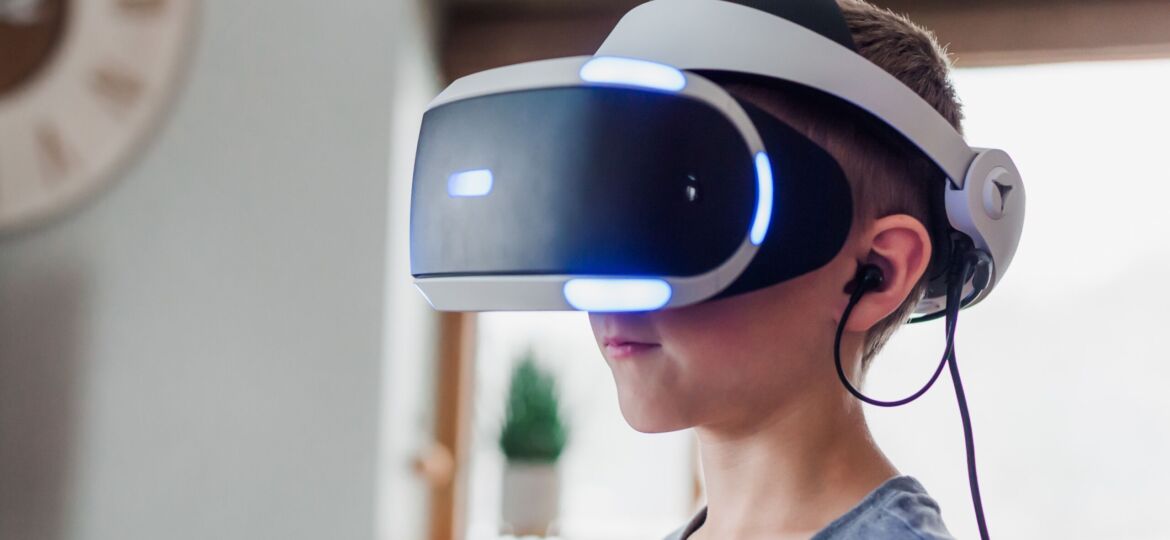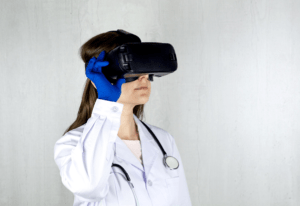
Most of you may have heard about virtual reality sometime or the other. Most people are familiar with VR headsets that can be worn like Goggles. Let us do understand all about Virtual reality in this blog.
Definition
Virtual reality is a completely digital experience, a user needs to wear a virtual headset via which he/she can indulge in a 3D environment. It can either simulate the real world or may be fictional as well. A person using VR can interact with the artificial world by looking around, moving, etc.
VR mostly focuses on two senses out of five, i.e., Sound and Vision. More high-tech VR that works on haptic technology can incorporate the use of other senses as well, which makes it more immersive and enjoyable. The most popular VR headsets available in the market are Samsung Gear VR and Oculus Rift.
What is the purpose of Virtual Reality?
Virtual reality not only aims to entertain its users with the immersive experience but also has lots of potential in educating people. Other than the gaming and entertainment industry, Virtual reality can be applied in industries like medicine, architecture military, and many more.
The immersive experience makes the user more engrossed and gives a feeling that he/she is present there. The fantasy within the head of being there and getting a feeling of actually experiencing it is quite attractive to the users.
Types of Virtual Reality
There are three main types of virtual reality, which include- non-immersive, semi-immersive, and fully-immersive simulations.
- Fully-immersive simulations
Fully immersive VR is possible to experience with the help of VR headsets. This type is commonly seen in the gaming or entertainment industry. They give the most realistic experience via stimulating the visual and auditory senses of the user.
- Semi-immersive simulations

This type of VR is used mostly for educational purposes, the best example being the simulation training given to the pilot. The devices and machinery are real but the environment of Sky and weather is created virtually, to help the pilot learn. Although being semi-immersive, it can still give the feeling of being in a different reality than the actual.
- Non-immersive simulations
Normal Video games are considered under non-immersive simulations. With VR getting so advanced this category can easily be dropped. This type of VR creates a computer-generated environment and users can use a keyboard mouse etc to play or interact. The user is not immersed in the experience as he/she is well aware of his physical environment.
5 Important Elements of Virtual Reality (VR)
- Viewing System
Virtual reality can be best experienced with a good, high-quality viewing system. The immersive experience is not possible without this.
- Tracking System
The VR headset needs a sensor camera to capture the movements of the user.
- Interactivity Element
When the user is given the ability to interact with the objects within the virtual reality makes it more interesting and subversive. The interaction will depend on factors like range and mapping.
- Artistic Inclination
To give the feel of reality the VR should be designed in such a way that the small details of atmosphere, motion, and interaction with objects are taken under consideration, the overall experience should be engaging and entertaining.
- Sensory Management System
The ability to experience a vibration, shift change in movement, or speed will titillate the senses and help produce an even better experience for the user.
How Virtual Reality (VR) Technology Works
Virtual reality places a lens in front of the user’s eyes, it could be one lens or at times two lenses. These lenses adjust as per the eye movement of the user. To create an immersive experience – A minimum 60fps frame rate and a good refresh rate are compulsory.
Also, the view of the field should be 100 degrees. Any discrepancy in the above may result in latency, To trick the brain from getting the feeling of actually being there, a response time of 20 milliseconds or less is necessary.
Virtual Reality Applications
Apart from gaming and entertainment, VR is used in several other industries.
- Healthcare

Everyone will agree that the human body is very complicated, no wonder doctors undergo lots of training before performing any surgery. VR in healthcare helps practitioners to practice for critical surgeries and make themselves better. VR in healthcare is also used to cure some mental diseases like phobias and anxieties.
- Automotive
All of us have heard of self-driving or smart cars, these are under development with the use of virtual reality and artificial intelligence. Also, the automotive industry uses VR to analyze how the newly developed car will behave on various types of roads.
- Education and military
VR systems help students and soldiers learn about various topics and situations. Anything that engages two or more senses while learning helps a person to learn faster. VR can be extensively used in various types of training.
- Architecture
Using VR architects cans gauge the feel of the building and deliver their clients in a better manner.
- Tourism
VR may help to boost the tourism industry a lot. Travel companies can give a VR experience to the prospective customer to show a monument, landmark, hotel, or restaurant, which will make the user choose wisely and reduce the chance of disappointment.
Pros and cons
Pros
- Reduces training costs by replacing it with VR systems
- Ability to provide a more immersive experience
- VR headsets are available in various price ranges
- Learning from VR can increase the grasping manifold.
Cons
- VR content may not work readily on different platforms
- VR content creation is expensive
- VR can make a person go into other reality completely and some may face severe addiction t
- Adoption of technology is a little slow
- Some people feel sick after using VR, symptoms similar to motion sickness.
Who wouldn’t want to be trained in an interesting way rather than the traditional book and lecture format? Who wouldn’t love to drive a car on a simulator rather than risking life by actually driving it on road? The fact is we all would love to do that.
All tech giants are highly supporting VR and advancing in it to improve their services. Companies are developing wireless headsets with 8D video quality, which sounds amazing. With the high growth potential, VR will be commonly used by all of us and shape our future.